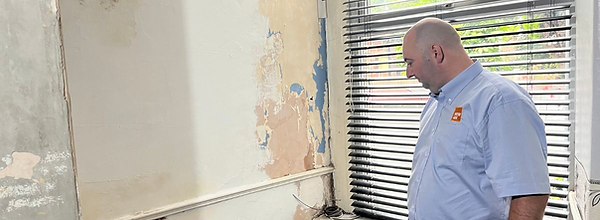
UK Housing Market
What every first-time buyer needs to know (before it’s too late)
Nicholas Donnithorne, UK Technical Manager at Peter Cox:
Buying your first home is a major milestone, filled with excitement and anticipation. But alongside choosing paint colours and planning where the furniture will go, there’s a more practical, but equally important, responsibility: looking after your property. For first-time buyers in particular, understanding the common risks that come with home ownership is critical to avoiding costly surprises.

RICS
Why a Pre-Purchase Survey is a Non-Negotiable
One of the most valuable steps a buyer can take is commissioning a proper survey before completing the purchase. It’s important to understand that a mortgage valuation survey is a basic assessment of the property’s value and is not a condition survey. It is primarily for the lender’s benefit and won’t tell you if there are serious issues like damp, structural movement or timber decay or highlight any potential repairs.
A recent survey of 2,000 UK homebuyers highlighted just how serious the consequences of not having a proper survey undertaken can be. It found that 44% of new homeowners discovered they needed significant repairs within the first year of owning a property, with 61% of those repairs considered “substantial.” Almost half spent over £3,000, and 15% faced repair bills exceeding £10,000, a major blow for anyone, let alone those already stretched by the upfront costs of buying a home.
The most commonly reported problems weren’t cosmetic; they included:
-
Electrical rewiring (32%)
-
Window replacements (30%)
-
Roof repairs (30%)
-
Plumbing and drainage issues (30%)
-
Damp treatment and new damp proof courses (26%)

Peter Cox
These are precisely the types of issues that a RICS Level 2 or Level 3 survey can detect before you commit. These surveys provide detailed insight into a property's condition and alert you to hidden issues or potential risks, giving you a powerful tool to renegotiate your offer, budget accordingly or rethink the purchase entirely.
The chartered surveyor will recommend you get an additional survey from a specialist such as Peter Cox. Peter Cox offers detailed property surveys to identify and address issues like damp, wood rot, and woodworm. Their accredited surveyors use advanced tools such as thermal imaging cameras to conduct thorough internal and external inspections. A detailed report is provided within three days of the survey, including findings, photos, suggested treatment or works required, and outline costs.
What to Watch for Once You’ve Moved In
Once you’ve got the keys, your responsibility shifts to maintenance and early problem detection. Common issues we see time and again at Peter Cox include:
-
Damp (Rising and Penetrating): Moisture entering through walls or rising from the ground can lead to musty odours, mould, and damage to plaster or timber.
-
Condensation: Typically an issue in the colder months of the year that can cause black mould to grow, especially in poorly ventilated areas like kitchens and bathrooms.
-
Woodworm and Timber Decay: Small exit holes and fine dust may be early signs of wood-boring beetle infestation whilst wood rot may be visible as cracked paintwork or soft timber. Both can compromise structural timber if left unchecked.
-
Basement Water Ingress: If your property has a cellar or basement, be alert to signs of leakage such as peeling paint, persistent damp smells, or white salt deposits (efflorescence). Waterproofing or tanking systems may be needed to protect against groundwater problems.
Budgeting for the Unexpected
As the survey results show, unexpected repairs aren’t uncommon, and they can be expensive. That’s why I always advise homeowners, especially first-time buyers, to build a maintenance fund into their financial planning. A general guideline is to allocate around 1% of your property’s value annually for repairs and upkeep, though this may vary depending on the building’s age and condition.
Preventive care is always cheaper than remedial work. Something as simple as regular gutter maintenance or checking for early signs of damp can help you avoid major disruption later on.

Peter Cox
The Role of Professional Support
Identifying property issues can be complex, and getting it wrong can lead to misdiagnosis and wasted money on ineffective fixes. Engaging a qualified property care professional to undertake a survey offers:
-
Accurate diagnosis: Knowing whether a damp patch is due to condensation or rising damp is essential for effective treatment.
-
A long-term solution: Professionals use proven techniques, specialist tools, and often provide guarantees.
-
Cost-efficiency: Proper resolution of problems the first time prevents escalating damage and the need for repeat repairs.
Final Thoughts
Your first home should bring joy, not financial stress. The best way to ensure this is by taking property care seriously from day one. That means investing in the right pre-purchase property survey, staying vigilant for early signs of trouble, budgeting realistically, and turning to trusted professionals when needed.
At Peter Cox, we’ve seen how early intervention and expert advice can transform a potentially stressful situation into a manageable one. With the right knowledge and preparation, you can enjoy the excitement of home ownership without the hidden headaches.
